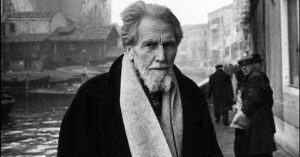Anthony Burgess and Modernism
-
Graham Foster
- 17th June 2019
-
category
- Blog Posts
Anthony Burgess came of age as modernism was approaching its peak, and the movement influenced much of his writing and music. As a young man, Burgess was inspired by writers such as James Joyce and T.S. Eliot; and, as a musician, he was excited by the revolutionary compositions of Stravinsky, Berg, Honneger and Mossolov.
Reacting against the realism of the late nineteenth century, modernist literature aimed to disrupt the established patterns of novel-writing and poetry. Omniscient narrators, linear structures and external description were replaced by subjectivity, fractured plot-lines and a focus on the internal thoughts of characters (inspired by the rise of psychoanalysis). Modernist poets experimented with form and allusion, building collages out of fragmented languages and images. The modernist project as a whole could be summed up in Ezra Pound’s command: ‘Make it new’.

Burgess’s first encounter with modernism came through his reading of Joyce’s A Portrait of the Artist as a Young Man at the age of fifteen. He describes the hellfire sermon as being so fear-inducing that it temporarily drove him back to the Catholic church. It was in the mid-1930s, when he was still at school, that he read Joyce’s Ulysses, which he described as a decisive moment in his artistic formation. While Ulysses was a constant presence throughout his career, he later wrote that the post-Ulysses novelist ‘is forced to pretend Ulysses does not exist’, and that Joyce’s achievements made him cautious about beginning to write his own fiction. Nevertheless his first novels of the 1950s followed Joyce in superimposing a contemporary story onto a mythological framework. In A Vision of Battlements he refers back to Virgil’s Aeneid; and The Worm and the Ring retells the story of the Niebelungenlied.
Above all, what Burgess takes from Joyce is the elevation of language above everything else. He writes: ‘If Joyce taught nothing else he certainly taught a rigorous attention to language – an aspect of the traditional British novel which is generally despised.’ In each of his novels Burgess experiments with language to a greater or lesser extent: sometimes in overt ways, as in A Clockwork Orange and Nothing Like the Sun, and sometimes in more subtle ways the Enderby books and One Hand Clapping.
Despite Burgess’s early connection to Joyce, it was T.S. Eliot who galvanised his artistic interest in modernism. He first read Eliot when he borrowed The Waste Land from the public library in Manchester before he’d left school. For the young Burgess, this poem became his gateway to Dante and Baudelaire, and he quickly memorised the text in its entirety. On a trip to London in 1936 he bought Eliot’s Collected Poems from a bookshop on Charing Cross Road. He began reading the poems on the train back to Manchester, and was so taken with Eliot’s work that he immediately wrote musical settings of the songs from Sweeney Agonistes. The impact of Eliot’s work on Burgess was substantial, as he admitted in an article written shortly after Eliot’s death: ‘The tastes of most of us have been Eliotian for the past forty-five years. He was a maker in a double sense: he made not only his poetry but also the minds that read it. To reject Eliot was to welcome anarchy.’
Burgess’s analysis of Eliot’s influence recalls his writing about Ezra Pound. He describes Pound’s Cantos and his Homage to Sextus Propertius as ‘immensely important, supreme examples of the development of an idiolect, a personal language, which became the language of a whole generation.’ He made a musical setting of lines from Pound’s Canto XXX, and Pound is an important figure in Burgess publications such as Ernest Hemingway (1978) and the novel Earthly Powers (1980), in which he features as a character.

It was with the voices of Joyce, Pound and Eliot in his head that Burgess began writing fiction and his experiments with form, narrative and language owe these writers a large debt. Burgess’s clearest experiment in modernist expression came in 1974 when he published Napoleon Symphony. As with Joyce’s work (and indeed his own early work), the novel rests on a mythic framework. Burgess maps the biography of Napoleon onto the myth of Prometheus, but in another layer of complexity, he also frames the narrative around Beethoven’s Eroica symphony (which borrows one of its themes from Beethoven’s Prometheus ballet music). The story is told in a high modernist style, linguistically complex and fragmented.
Some critics have argued that Burgess embraced postmodern literary forms in his playful novel MF, based on the structuralist theories of Claude Levi-Strauss. This makes it difficult to categorise Burgess’s own writing, although the best depiction of various literary movements of the twentieth century may be found in Earthly Powers. As the protagonist Kenneth Toomey arrives at his eighty-first birthday, he has experienced the blossoming of the modernist movement and the emergence of a postwar culture which might be termed post-modern. It is possible that, through the figure of Toomey, Burgess was thinking of his own creative maturation through the different artistic movements of the last century.
The Burgess Foundation’s new exhibition ‘Anthony Burgess and Modernism’ explores these themes in detail. The exhibition, which runs from 17 June until 30 September 2019, is free and open weekdays from 10:00 am to 3:00 pm, and in the evenings during events.
Anthony Burgess’s books Here Comes Everybody: An Introduction to James Joyce for the Ordinary Reader and Flame Into Being: the Life and Work of D.H. Lawrence have been newly reprinted by Galileo. Click here for more information.


